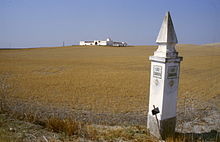Andalusia
![]()
The title of this article is ambiguous. For other meanings, see Andalusia (disambiguation).
Andalusia (Spanish Andalucía [andaluˈθi. a]) is the southernmost of Spain's 17 autonomous communities, located on the European mainland. Andalusia borders Castile-La Mancha and Extremadura to the north, Murcia to the east, the Mediterranean Sea, the British Overseas Territory of Gibraltar, and the Atlantic Ocean to the south, and Portugal to the west. The capital of Andalusia is Seville. The headquarters of the Supreme Court of Andalusia is located in Granada.
With around 8.44 million inhabitants, Andalusia is the most populous autonomous community in Spain and the second largest in terms of surface area with 87,268 km².
The most important natural areas of Andalusia are the southern slope of the Sierra Morena, the basin of the Guadalquivir and the Betic Cordillera, which includes the Sierra Nevada. The Campo de Gibraltar, with the Rock of Gibraltar forms the southernmost part of mainland Europe. At Tarifa, the southernmost town, Europe and Africa are only 14 kilometres apart, separated by the Strait of Gibraltar.
Andalusia was often fought over in the past. Therefore, there were many cultural influences, such as the Arabs or the Romans.
The region is also known for its music, especially flamenco.
Provinces
Andalusia is divided into eight provinces with a total of almost 700 municipalities (municipios):
| Province | Population | Area (km²) | Communities | Official Districts |
| Almería | 716.820 | 8774 | 102 | 8 |
| Cadiz | 1.240.155 | 7436 | 44 | 14 |
| Cordoba | 782.979 | 13.771 | 75 | 12 |
| Granada | 914.678 | 12.647 | 168 | 9 |
| Huelva | 521.870 | 10.128 | 79 | 6 |
| Jaén | 633.564 | 13.496 | 97 | 10 |
| Málaga | 1.661.785 | 7308 | 100 | 11 |
| Sevilla | 1.942.389 | 14.036 | 105 | 15 |
Besides the provincial capitals of the same name, Jerez de la Frontera and Ronda are among the most famous cities in the region.
The most densely populated areas are the valley of the Guadalquivir and the coastal strip south of the Sierra Nevada.

Landscape near Carmona in Andalusia
Origin of the name
The Moors who invaded at the beginning of the 8th century gave the province the Arabic name al-Andalus (الأندلس). From this came the name Andalusia (Spanish Andalucía). There are various interpretations as to its origin. The only certainty is that the name al-Andalus first appears on a bilingual coin around 715/717 as a designation for the entire Moorish dominion on the Iberian peninsula.
A popular legend, often attributed to the Orientalist Reinhart Dozy, but attested long before the 19th century, which is hardly held among historians today, traces the Arabic al-Andalus back to the name of the Vandals, who in the course of the migration of peoples in the 5th century made a stopover in the south of the Iberian peninsula and founded there a state with the original name Vandalusia.
The Spanish historian Joaquín Vallvé attributes the name of Andalusia to an Arabization of the name Atlantis.
A theory of the Arabist Heinz Halm from the 1980s derives al-Andalus from *landa-hlauts, the name the Visigoths are said to have given to the former Roman province (Hispania) Baetica - "the land distributed by lot". As evidence, Halm cites the official Latin name of Visigothic Spain: Gothica Sors, which translates roughly as "Goth lot" or "lot of the Goths", which he in turn independently retranslates into Gothic as *landa-hlauts. After the conquest of Spain, the Moors would have made al-Andalus out of it in the form of phonetic imitation.
A more detailed investigation from the year 2002 makes it seem plausible that 'Andaluz' is the original Old Iberian, and thus still pre-Roman name of today's island Isla de Tarifa at the Strait of Gibraltar, and thus at the extreme southern tip of Spain, because the initial syllable And- as well as the final syllable -uz are extremely common in pre-Roman Iberian place names. Two to three hundred years after the Moorish conquest of Spain an Arabic source reports for the first time about the island al-Andalus, which since the conquest of Spain together with the city Tarifa had got the name of Tariq ibn Ziyad, its conqueror from the year 711. Its Arabic name, according to this theory, would have been Ǧazīrat al-Andalus "(half-)island of Andalus" at first, which then, as the Arabic source continues, extended as pars pro toto to the entire Arab domain in Hispania with the conquest of the Iberian mainland (which began a year later).
Questions and Answers
Q: What is the most populous Autonomous Community in Spain?
A: Andalusia is the most populous Autonomous Community in Spain.
Q: How many provinces does Andalusia have?
A: Andalusia has eight provinces, which are Almería, Cádiz, Córdoba, Granada, Huelva, Jaén, Málaga and Seville.
Q: What is the capital of Andalusia?
A: The capital of Andalusia is the city of Seville (Spanish: Sevilla).
Q: Where is Andalusia located on the Iberian Peninsula?
A: Andalusia is located in the south of the Iberian peninsula. It lies just to the south of Extremadura and Castile-La Mancha; west of Murcia and the Mediterranean Sea; east of Portugal and Atlantic Ocean; and north of the Mediterranean Sea and Strait of Gibraltar.
Q: Does any other country share a land border with Andalusia?
A: Yes, there is one other country that shares a land border with Andalusia - it's a small British Overseas Territory called Gibraltar at the eastern end of Strait of Gibraltar.
Q: What body of water borders both sides of Andalusia?
A: The Mediterranean Sea borders both sides (east & north)ofAndalucía.
Search within the encyclopedia